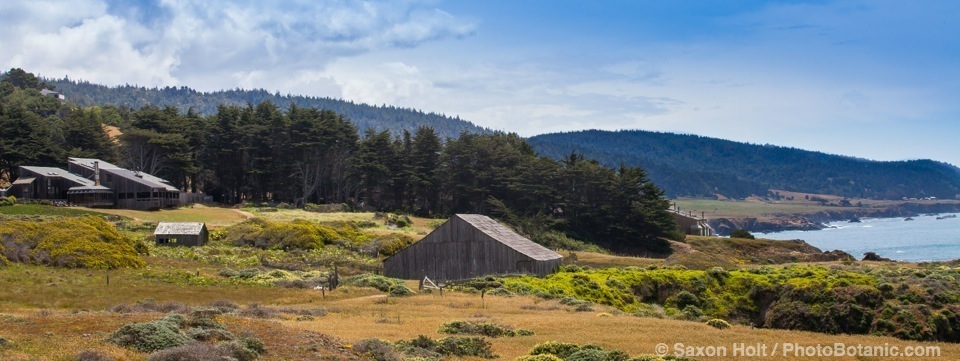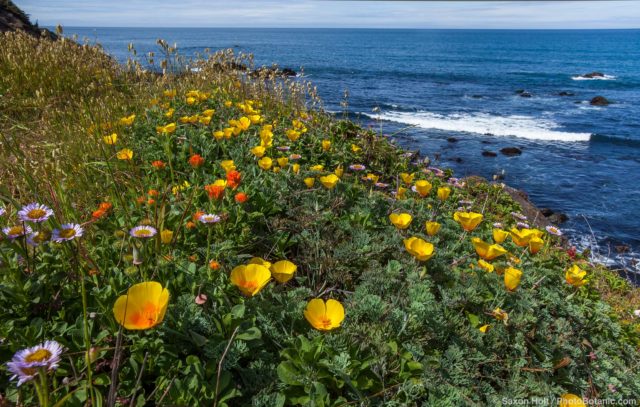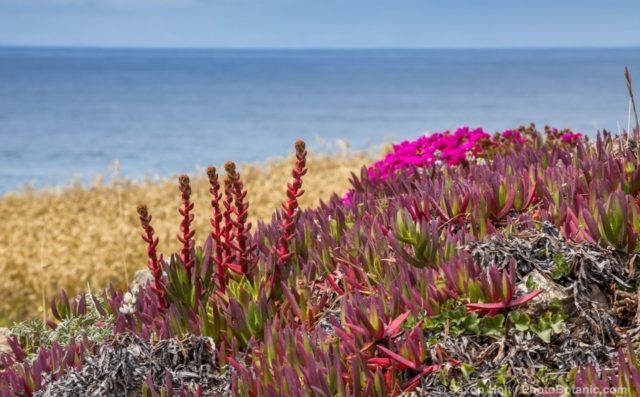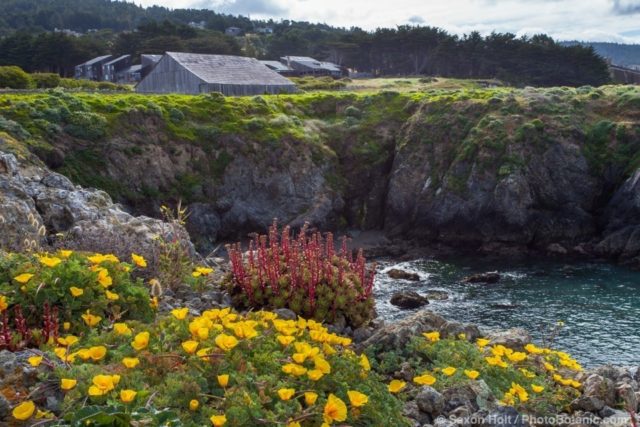In the early 1960’s, ten miles of California’s Sonoma Coast was designated for development, in an era before there was any regulatory agency overseeing coastal development. The Sea Ranch became legendary in the annals of California Coastal development, and as a result, the California Coastal Commission has clamped down on every permit.
Yet, despite the hundreds of homes built and thousands of lots, The Sea Ranch has preserved the natural integrity of the land and the spectacular views of the ocean.

California wildflowers on coastal bluff at Black Point – across from Sea Ranch Lodge and Bihler Point.
The bluffs, meadows, and forests are preserved due to farsighted local developers who loved the land and brought in a master landscape architect, Lawrence Halprin, who wrote in The Sea Ranch . . . Diary of an Idea:
“At The Sea Ranch we have developed a community based in wild nature and sustained by its beauty. We have an important responsibility here. What do we bring to this environment and how do we alter it? I feel myself a custodian rather than an owner of it. . . . I feel I owe constant vigilance and care for its poetic and spiritual survival. I hope those who follow me feel the same”.
Only California native plants are allowed to be planted on any visible landscaping at The Sea Ranch, and even within the limited, very small fenced private garden areas, no non-native may be taller than the fence.
The character of the land has been preserved by the covenants of the project. The original Monterey Cypress hedgerows that protected the original ranches became the landscaping motif for developing clusters of houses around open meadow areas of the California Coastal Terrace.

Coastal homes around Sea Ranch meadows seen from Black Point Beach.
Lawrence Halprin: “I realized then that it was this character that I hoped we might achieve at Sea Ranch, a feeling of overall place, a feeling of a community, in which the whole was more important and more dominant than its parts. If we could achieve that – if the whole could link buildings and nature into an organized whole rather than just a group of pretty houses – then we could feel we had created some- thing worthwhile which did not destroy, but rather enhanced the natural beauty we had been given.” (The Sea Ranch Covenants).
As part of the development, public access has been preserved at designated trails and especially at the Sea Ranch Lodge, with historic old ranch buildings, where paths through meadows to ocean vistas are part of the commitment to share the natural landscape that The Sea Ranch celebrates with the public. As such, one would think it would be a showplace of native ecosystem, a place visitors from all over the world can see firsthand the stunning interface between the ocean and the land, and see how native plants define the habitat.
Instead, it is one of the most disturbed plant ecosystems along the coast, covered with non-native and invasive plants. It is being loved to death, for where ever humans go, weeds will follow. The most used trails at Bihler Point, in the expansive Coastal Terrace meadow, below the Sea Ranch Lodge, is a textbook example of a disturbed ecosystem, covered with non native grasses, mustards, and thistles; and now, especially at Black Point, encroaching iceplants.
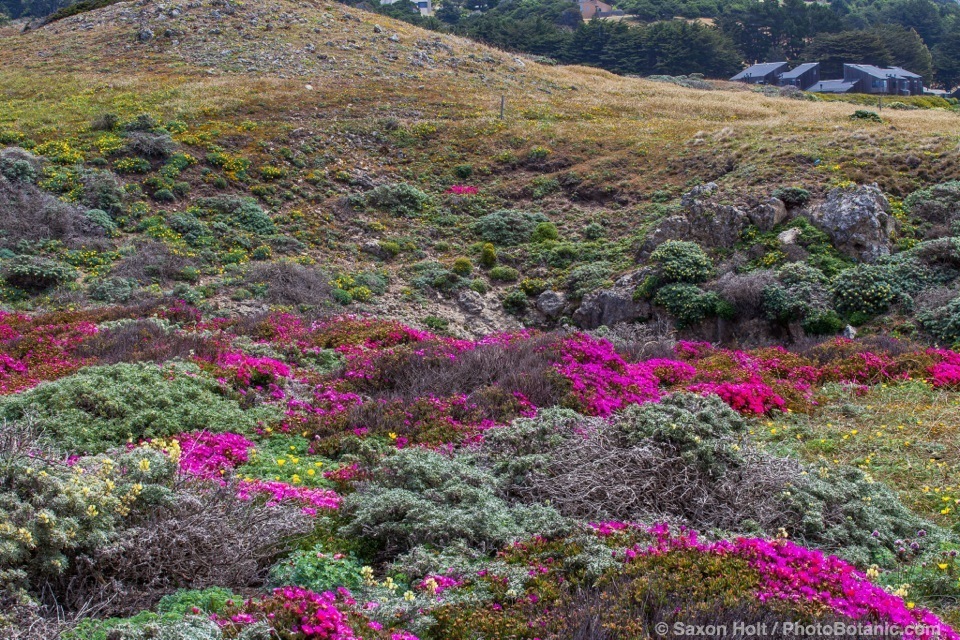
Carpobrotus chilensis – Sea Fig Ice Plant, invasive flowering succulent in coastal bluff at The Sea Ranch
Despite the good intentions of the Comprehensive Environmental Plan, declaring the “challenge was to demonstrate that people can inhabit a beautiful and fragile land located along a wild stretch of the California coast without destroying it”, the native plants are being overwhelmed by invasives.
It is particularly sad to see the ice plants overwhelming the natives, not just because of the harm: “iceplant is a succulent, it takes and stores water and nutrients from the soil, making survival much more difficult for native plants.” (California State Parks Bulletin), but visitors think they are a natural part of the California Ocean Bluff ecosystem. Every happy tourist I encountered hiking the bluffs on recent visit was surprised to find out the bright colorful flowers were not native.
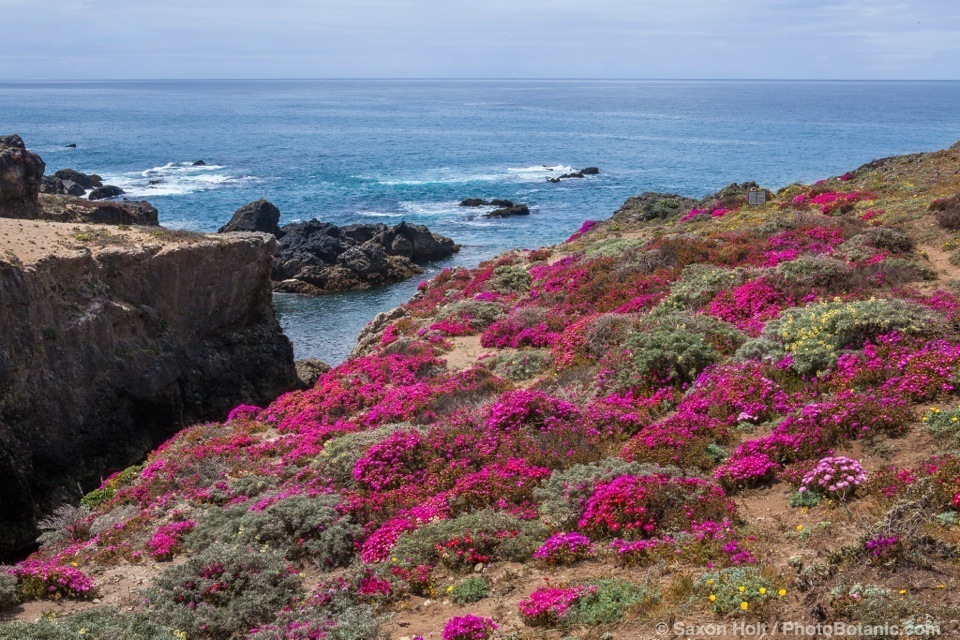
Carpobrotus chilensis – Sea Fig Ice Plant, invasive flowering succulent in coastal bluff at The Sea Ranch
Whenever possible, I directed nature lovers to a wonderful, nearly intact community of native wildflowers at the peak of flowering atop a bluff overlooking a cove, on a different part of Black Point.
Except for a few inevitable alien grasses spoiling this plant community, yellow Coastal strain of California poppies mixed beautifully with native Alliums, Erigerons, Armeria, and Dudleya – a native succulent.
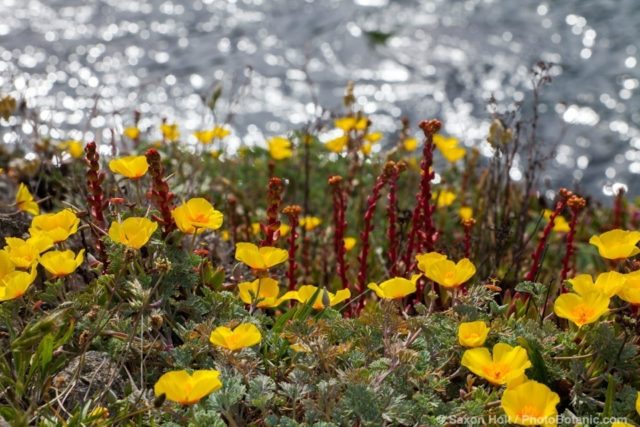
California native wildflowers Dudleya farinosa and yellow coastal form of California poppy at The Sea Ranch
This succulent, Dudleya farinosa, known as Bluff lettuce, or Powdery Liveforever, clings to rocky outcroppings all along the coast, but here it must outcompete the invasive succulents, two varieties of Carpobrotus, both C. edulis (not flowering) and C.chilensis (flowering).
It’s difficult to recognize native plants if you are not familiar with the habitat, and the California Coastal Bluff ecosystem is a spectacular landscape no matter what plants adorn them. I hope the folks at The Sea Ranch will take the time to restore the natives so visitors will get a true picture of the landscape.
The Planning Committee developed a Comprehensive Environmental Plan, a Sense of Place that states: “This land, with its breathtaking vistas and rich biotic communities, both delights the eye and restores the spirit. It has been from the beginning, and continues to be to this day, a cornerstone of The Sea Ranch sense of place . . . The environment continues to be restored and nurtured . . . The Sea Ranch designers prioritized restoration of the natural setting at the onset of their project”
While the larger landscape is preserved, alien plants are sneaking in. The natives are so special, such as the yellow Coastal Form of the native California poppy, lets’ hope visitors get a chance to see the real thing.

